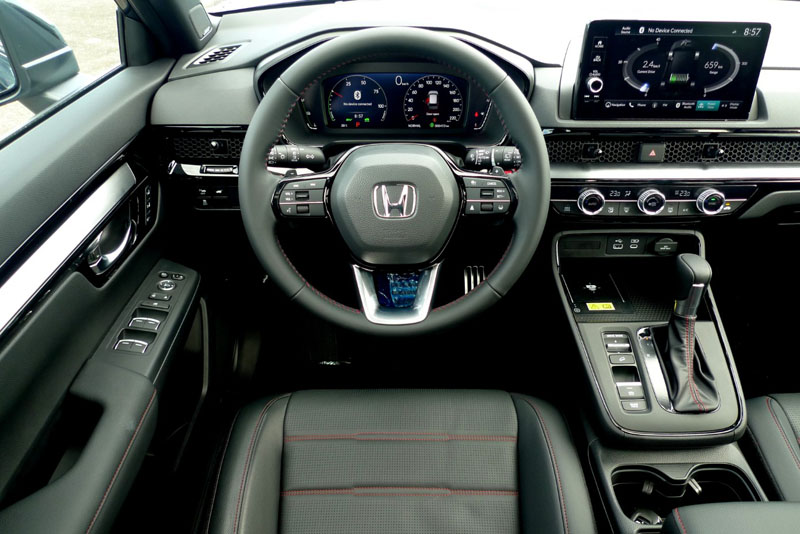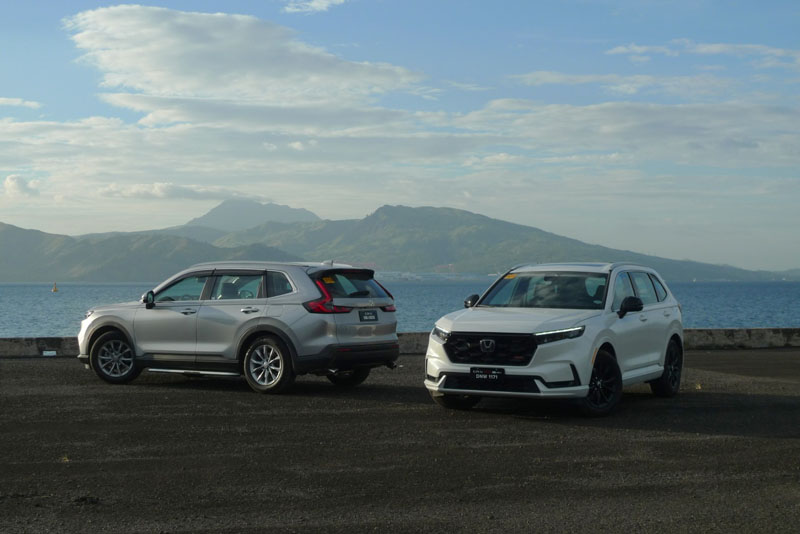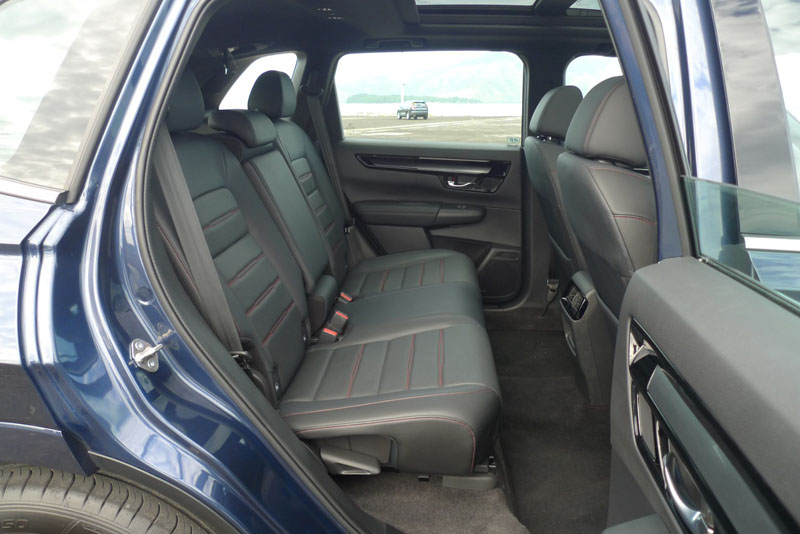
Is Honda lagging behind other brands in the shift to electrification? Not at all. You might have forgotten that, before it was in fashion, Honda came out with the Legend hybrid, Insight Hybrid, and CR-Z two-door mild hybrid. I believe they even gave the Department of Energy a hybrid Civic many years back.
In fact they have hybrids and EV’s in other countries. It’s just that their game plan for the Philippines is a little different. Now that we’re finally catching up, they recently launched the hybrid all-new CR-V.
All-wheel drive

We were invited to join a drive out to Bataan and Subic to try out all three variants of the all-new CR-V: the V CVT Turbo FWD, the VX Turbo CVT AWD and the RS e-HEV. The first variant we got to drive was the VX Turbo CVT AWD. My car mates and I loaded up our gear and our route was up to NAIAX and onto NLEX via Skyway 3.
The AWD variant performed as well as expected, especially since there wasn’t much traffic to deal with on the elevated highway. Honda SENSING is useful as we were able to set our adaptive cruise control to the 60-kph speed limit and distance to the vehicle up front. This made cruising much easier as the CR-V took care of braking if the vehicle ahead slowed down.

Honda stayed faithful to what CR-V stands for, being a “Comfortable, Roundabout Vehicle,” still offering comfort, generous space and amenities in all three variants.
Under the hood is a Euro-4 compliant turbocharged DOHC DI VTEC 1.5L 4-cylinder 16-valve gasoline engine which puts out 190-Ps at 6000 rpm with 240-Nm of torque between 1700-5000 rpm, mated to a CVT that sends power to Honda’s Real Time all-wheel drive system. This variant is equipped with an Econ mode button which we used for most of the drive as the steady speeds on the expressway didn't really need instant response even on overtakes
On SCTEX, we exited at Dinalupihan. We hit the two-lane country roads and made our way to Bataan. The CR-V’s AWD made short work of getting around jeepneys and tricycles. Switching off the Econ mode made the sedate crossover SUV more aggressive and power delivery was almost instant with the turbo good to go at low rpm’s, making power readily available.
Our lunch venue, the sosy Rancho Bernardo Luxury Villas and Resort, had an expansive property and some nice locations to photograph the all-new CR-V where you could actually see both Las Casas Filipinas de Acuzar and the Bataan Nuclear Power Plant.
Front-wheel drive

After lunch, we changed vehicle and got to try Honda’s base CR-V variant, the V Turbo CVT, which was pretty much the same as the AWD in most aspects, but was front-wheel drive. The roads leading out from Bagac, Bataan and coming into Subic (SBMA) were still two-lane roads, but the turns were tighter and since there were less public vehicles on this route. We opted to drive a bit faster than we did before lunch. My car mates and I were surprised at the response and sharp handling this base variant showed. For a front wheel drive, it had no problems keeping up with the convoy of Hybrid and AWD variants. Our final stop was where we would be spending the night, the Kamana Sanctuary Spa Resort. The sunsets here are quite spectacular.
Hybrid
We finally got to drive the RS e:HEV variant on the home stretch from SBMA back to Manila. The top of line variant as expected was well equipped and did not disappoint on the road. Our locally available hybrid is FWD only. But for Philippine conditions is more than enough.

Under the e:HEV’s hood is a Euro-4 compliant VTEC four-cylinder 16-valve 2.0L DOHC DI Atkinson Engine which puts out 148-Ps at 6100 rpm with 183-Nm of torque at 4500 rpm. This is mated to the Honda’s dual motor hybrid system, with the drive motor putting out 184-Ps between 5000-8000 rpm with 335-Nm of torque between 0-2000 rpm. The electric motor runs off a 1.06-kWh battery and can theoretically drive on pure electric roughly 54 kilometers. But this all depends on road conditions and charge state. Do bear in mind that the CR-V will switch from battery power, to gas and both while you go about your daily drive, so don’t expect to go that distance on full electric. The drive mode you select will also determine how the vehicle will switch between these power sources.
The roads coming out from Kamana and into SBMA are nicely paved and allowed us to get a feel for the handling and power delivery of the RS e:HEV, as expected the seamless switching from battery and gasoline engine was completely unobtrusive and allowed us to enjoy the drive back to Manila.

The all-new CR-V is a fun crossover SUV that doesn’t drive as big as it looks. It’s easily manageable in the city and tight mall parking. Most traffic noise is blocked out and generous interior space stops you getting claustrophobic. Both 2WD and AWD variants are seven-seaters while the RS e:HEV is a five-seater.
All variants are equipped with a nine-inch touchscreen infotainment system with Apple Carplay and Android Auto. The V and VX variants are equipped with eight speakers and the RS has a 12-speaker Bose speaker system. Cabin comfort is upped by dual and tri-zone air conditioning. There’s a wireless 15W charging pad in the center console of the dash and USB A and C ports next to that and two USB C charging ports for the second row occupants and two 12V sockets, one up front and one in the cargo area.

As we learned on this drive, all three variants do well on the open road, handling, comfort, cabin space and luggage room, of course depending on whether you have third row occupants in the V Turbo CVT 2WD and AWD variants. All variants are equipped with Honda SENSING, giving you peace of mind on the road that the CR-V itself is actively looking out for your safety.
The V Turbo CVT is priced at P2,100,000, the VX Turbo CVT AWD is P2,280,000 and the RS e:HEV E-CVT is priced at P2,590,000.
My car mates and I agreed that our favorite was the V Turbo CVT or base variant. Without the additional burden and weight of AWD drive system, the power delivery was just a bit quicker in the V than the VX. It’s also the most affordable of the lot. Of course the e:HEV takes the cake with overall features, performance, an awesome sounding audio system and Honda CONNECT, but if you’re looking for good value, seats seven, economical but offers up performance when you need it, the 2WD V Turbo CVT is really good.